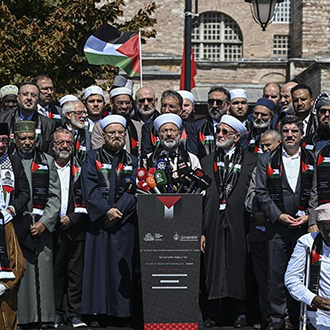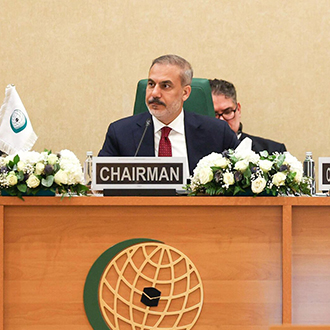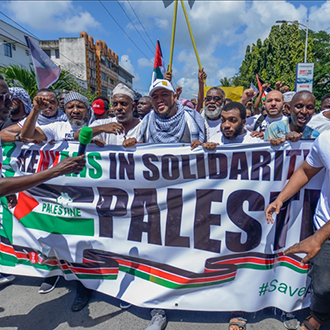When our beloved Prophet approached Mecca, he learned from the people he met on the way that the members of Banu Thaqif had already sent word to the Quraysh. In this situation, he could not enter Mecca without protection. Since all the Muslims, including powerful men like Abu Bakr and ‘Umar ibn al-Khattab, were at odds with their tribes, he could not ask them for help in this matter. He waited on Mount Hira until he found a tribe leader from Quraysh who would protect him. While many people did not respond positively to his request, Mut‘im ibn ‘Adiyy, the chief of the Banu Nawfal, who was renowned for his efforts in lifting the boycott against his tribe, accepted his plea for protection. Mut‘im took his sons, whom he had armed, to Hira and brought the Prophet Muhammad to the Ka‘bah. After announcing to the polytheists there that he had taken the Prophet under his protection, he took him to his house and hosted him.
The Prophet did not find any favorable outcomes during his initial search for a safe refuge. The sorrow of losing his uncle and wife was compounded by the agony of enduring stoning, mockery, and insults on his journey to Taif.
First contact with Yathrib
Despite facing such challenges, our beloved Prophet persevered in spreading the teachings of Islam to various communities. Approximately a month and a half after returning from Taif, he took the opportunity to explain Islam to those who came to Mecca during the pilgrimage season, as he did every year. Despite his uncle Abu Lahab’s efforts to humiliate and discredit him, the Prophet Muhammad was able to convince a group of six people to accept the teachings of Islam at a place called ‘Aqabah, about 3 km away from the Masjid al-Haram. He shared with this group, who were from the Banu Khazraj tribe of Yathrib, the challenges he and other believers of the new religion had faced in Mecca. He discussed with them the idea of migrating to Yathrib, which would later be known as “Medina”. He hoped to meet again with the group of Banu Khazraj, who were his maternal relatives, later that year. They would also spread the word about Islam to others as much as they had learned until the next pilgrimage season, and consider the idea of emigration.
The events of Isra and Mi‘raj
Our beloved Prophet, who had endured a series of profound sorrows during the previous year, had yet to establish a safe environment for those who believed in him, despite exerting every effort within his human capacity. On the 27th night of the month of Rajab in 621, he received spiritual support from Allah when he felt despair and uncertainty. In this spiritual support, which some accept to have occurred physically (Ibn Kathir, II, 477) and others spiritually (Ibn Ishaq, 462; Ibn Hisham, II, 253; Al-Baladhuri, I, 296), the Prophet Muhammad was transported from the Masjid al-Haram in Mecca to the Masjid al-Aqsa in al-Quds, accompanied by the angel Jibril. From there he ascended with Jibril to the sublime place called Sidrat al- Muntaha. Then he was presented before Allah the Almighty, transcending the constraints of time and place. With this spiritual support, he was given the glad tidings that Islam would spread from the city of Mecca, where it had been confined for ten years, to distant lands.
The Mi‘raj elevated the Prophet’s spirituality, strengthened the faith of the believers, and intensified the enmity of the polytheists. When the Prophet narrated this event to the Meccans, they dismissed it as unreal and attempted to put Abu Bakr in a difficult situation by sarcastically telling him about it. However, Abu Bakr responded by saying, “Did Muhammad say what you are recounting? If he says it, it is true,” and he confirmed it.
On the night of Isra and Mi‘raj, the Prophet was instructed to inform his followers that ritual prayer (salah) was made obligatory five times a day. On this night, the Prophet instructed believers as commanded by Allah to worship only Allah, treat their parents with kindness, fulfill their obligations to relatives, the poor, and those who are stranded, avoid being miserly or wasteful, refrain from killing their children due to fear of poverty, and abstain from fornication and adultery. He instructed them to refrain from taking a life or seizing orphans’ property, to fulfill promises, to measure and weigh accurately, to avoid pursuing matters without knowledge, to avoid pride and arrogance, and to not be haughty (Isra, 17:22-29).
The hope of emigration to Yathrib: the pledges of ‘Aqabah
As the Prophet endeavored to impart the teachings of Islam to his followers through new revelations, time passed amidst numerous challenges. He anxiously awaited news from the group in Yathrib, whom he had encountered during the previous year’s pilgrimage season. The end of the hardships that Muslims were going through, and their ability to practice Islam comfortably and set an example for future generations depended on the news they would receive.
The group of six came to Mecca in the month of Dhu al-Hijjah 621, as they had agreed. They met again at a place called ‘Aqabah. Our beloved Prophet found a group of 12 people, 10 from Banu Khazraj and 2 from Banu Aws. He assessed the situation with them. In addition to the Arabs, a significant number of Jews resided in Yathrib. Both groups were fragmented, lacking unity among themselves. Moreover, some Arabs cooperated and stood in solidarity with certain Jewish factions, while others opposed them and aligned with the remaining Jewish factions. These divisions led to civil wars that erupted periodically, almost resulting in mutual destruction. The most recent conflict between the two tribes occurred five years ago at a location known as Bu‘ath, resulting in numerous casualties on both sides. In fact, this fragmented structure lacking authority indicated that Yathrib was suitable for emigration. However, the people who had chosen Islam as their religion were still few in number. Most importantly, the tribal chiefs were unaware of the situation, and their support had to be secured. Considering all these factors, it was concluded that it was premature to emigrate to Yathrib.
Our beloved Prophet then explained the basic principles of Islam to his new acquaintances and obtained their promise that “they would not associate anything with Allah, would not commit theft or adultery, would not kill their children, would not slander each other, and would obey his commands”. He urged them to lead by example in Yathrib and encourage others to embrace Islam. The group, who had pledged their allegiance to him with their promise, left Mecca to reconvene a year after this meeting, which was termed the First Pledge of ‘Aqabah. Later, they sent a message to the Prophet, requesting assistance in explaining the new religion. Our beloved Prophet then sent Mus‘ab ibn ‘Umayr to Yathrib, who was wellversed in the verses of the Qur’an and the teachings of Islam.
Mus‘ab ibn ‘Umayr stayed as a guest in the house of As‘ad ibn Zurara for a year. During this time, he diligently worked to spread the message of Islam, his efforts bore fruit as a large number of people in Yathrib, including the leaders of two great tribes, Sa‘d ibn Mu‘adh and Usayd ibn Hudayr, embraced Islam. The Prophet was delighted upon hearing this news. Consequently, Yathrib became a suitable place for emigration.
Our beloved Prophet eagerly awaited the pilgrimage season of the year 622. This time, 75 people from Yathrib, including two women, came to Mecca to meet him. These people had ostensibly come for pilgrimage but their true intention was to meet the Prophet and invite him to Yathrib. Upon their arrival in Mecca, they secretly delivered the news to him and later met again at ‘Aqabah. The Prophet welcomed the invitation of the people of Yathrib to put an end to the negative experiences of those who believed in him. However, he did obtain a promise from them that they would protect him and the Muslims of Mecca, obey him, help him financially, enjoin good and forbid evil, and stand up for the truth without hesitation from anyone. The people of Yathrib accepted these conditions.
The Muslims in Yathrib chose twelve representatives to act as liaisons between themselves and the Prophet. These representatives were also responsible for explaining Islam to the people of Yathrib and making the necessary preparations for the migration of Muslims and the Prophet.
The Muslims of Yathrib left ‘Aqabah secretly without drawing attention to themselves. After this meeting called the Second Pledge of ‘Aqabah, our beloved Prophet gave permission to his companions to migrate to Yathrib.









